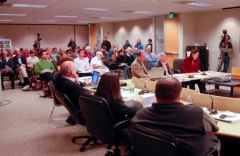
the hearing last night.
(Photos © J. Maus)
Last night in downtown Portland, the City’s Planning Commission heard three hours of testimony on the Portland Bicycle Plan for 2030. Despite a rumor that there would be “organized opposition” and that the plan would be in for a “bumpy night” and the scene would resemble the “unruly town halls on health care reform”, the night was actually quite tame.
Out of the entire three hours, there was only person — the infamous Terry Parker — who was in direct opposition to the plan (more on that below). A few others had solid critiques, but overall the plan received widespread support. In the end, the Commission decided to “hold open” the hearing until their next meeting on November 10th so they could “incorporate additional comment in the record” (according to Commissioner Chris Smith).
“When the number of trips made by bike outnumbers the number of trips made by car, we’ll know we’ve reached our goals.”
— Roger Geller, PBOT bike coordinator
(Read my live report from the hearing, and/or read below for a summary and further analysis.)
The hearing opened with an introduction from the Portland Bureau of Transportation’s (PBOT) Master Plan project manager Ellen Vanderslice who said the plan “articulates a transformative vision” for our city.
City bike coordinator Roger Geller than did a short presentation that focused more on aspiration than on wonky technical details. He illustrated Portland’s booming bike scene (from its culture to the economic impact) and said that “It has been the network that’s been at the foundation that everything has been built on.” Geller then laid out the chief strategy of the Plan:
“To advance, we need to reach out to the average people, the mainstream, people that ride not because they’re cyclists, but because it’s safe and comfortable… Our plan builds upon our bicycle legacy and will make bicycles a pillar of our city’s transportation system.”
“What is the better gateway drug to cycling, bike boulevards or off-street paths?”
— Chris Smith, planning commissioner
Geller also shared a few choice stats from the plan that definitely caught the attention of the Commissioners. Currently, he said, only 28% of Portlanders live within five blocks of a developed “low-stress” bikeway. Once the Tier One level of projects (a $100 million package that’s the first priority for the City) have been built out, that number will rise to 80%.
To put a finer point on the plan’s objectives, Geller said, “When the number of trips made by bike outnumbers the number of trips made by car, we’ll know we’ve reached our goals.”
“I don’t think it’s a question of either-or, we’d like to see it all.”
— Howard Shapiro, planning commissioner
Also lending official support to the plan were three members of the Master Plan Steering Committee: former City bike coordinator and now owner of a major planning firm Mia Birk, Bike Gallery owner Jay Graves, and representing the downtown business perspective, Randy Miller.
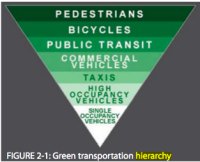
Birk focused on the “Green Transportation Hierarchy” concept that the plan intends to insert into City policy. That hierarchy would radically shift how the City approaches street designs, putting human-powered modes at the top and placing single-occupancy vehicles at the bottom. Graves said he’s excited about the plan because of how more trips by bike will mean less congestion as he drives his work truck around the city making deliveries between his six Portland-area stores. And Miller said Portland’s bike reputation is key in setting our city apart and can be a lucrative distinction for the business community.
As expected, trail advocates stepped up to share their concerns that the Plan focuses too much on the on-street network, at the expense of off-street path projects like the North Portland Greenway and Sullivan’s Gulch trails.
Adamski’s (and that of a Sullivan’s Gulch Trail committee member who read similar comments) testimony sparked dialogue from Commissioners Howard Shapiro and Chris Smith and marked what could become an important debate that shapes this Master Plan.
Trail advocates feel that the City’s strong focus on bicycle boulevards as a means to get more people on bikes, will not be as effective as a similar emphasis on large-scale, off-street path projects. Commissioner Smith said “This is a big issue for us” and he remarked how TriMet is taking just the opposite tact — by focusing on major MAX lines (off-street paths) over local service bus routes (bike boulevards). “What is the better gateway drug to cycling” he wondered, “Bike boulevards or off-street paths?”
Then it was Terry Parker’s turn. Parker is well-known for his disdain of pro-bike policies and bike projects. He said the plan is “one-sided”, that it’s outreach didn’t get beyond the “echo chamber of the bike community” and that the plan “treats bicyclists like elitists” that “expect expect mommy and daddy, in this case other taxpayers and motorists, to pay for the specialized infrastructure only they can use.”
The testimony that has gotten the most attention — including lead story treatment from KATU-TV last night — is that of Don Arambula, who was speaking on behalf of urban planning firm Crandall-Arambula. Arambula feels like the plan doesn’t go far enough and that its focus on shared, in-street facilities (bike boulevards) will not net the type of mode split he feels is possible in Portland. Arambula spoke in favor of more fully-separated facilities like cycle-tracks, which are ubiquitous in the cities with 35-40% bike usage rates Portland is trying to emulate.
“Portland will be lucky to get 10% [bike mode split] with [bike] boulevard approach. Protected bikeways are responsible for Copenhagen’s high bike ridership… Portland should be striving to become a world class bicycle city… The plan should clearly depict our city’s vision and should not be watered down by lack of current funding… a plan that doesn’t offer the best solution is a missed opportunity.”
Here’s KATU’s video coverage (featuring an interview with Arambula’s partner George Crandall):
Back in August, Arambula’s partner, George Crandall presented similar thoughts in a presentation to local bike insiders including BTA board members and staffers and members of Metro’s Executive Committee on Active Transportation.
Crandall’s vision — to create a network of fully-separated bikeways that reach key commercial centers — is an exciting one. However, PBOT plans to take a more pragmatic approach. To them, it’s a matter of budgetary constraints and political and public support, mixed with finding a strategy that has the best return on investment. To them, that is to build “developed bikeways” (which can mean a number of things, including bicycle boulevards) that will reach a large number of Portland residents.
PBOT feels that Portland does not yet have the public constituency that would give them the political cover to make the hard decisions necessary to create a large network of cycle tracks. Those decisions would include drastic makeovers of streets in commercial zones, removing parking throughout the city (which is known to rile feathers and also take meter revenue away from PBOT), including the Central Business District.
These are important issues that we’ll cover in the weeks and months to come.
Before last night’s hearing, Roger Geller said expected to “Hear it from both sides tonight… both from people who think we’re going too far, and others who think we’re not going far enough.” What happened is that he mostly heard from people in the middle.
The Planning Commission will make an official recommendation and vote on the Master Plan at their meeting on November 10th. From there, the plan must still be adopted by City Council in January. But the plan itself is just the opening salvo. The big question will be whether or not all the policy recommendations in it will be officially incorporated as binding City policy in much more powerful plans like the City’s Transportation System Plan and the over-arching Portland Plan.
Stay tuned.
— For full coverage of the Bicycle Master Plan/Portland Bicycle Plan for 2030, browse the 43 stories on it from our archives.


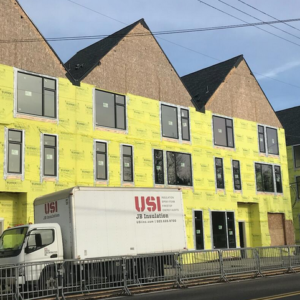
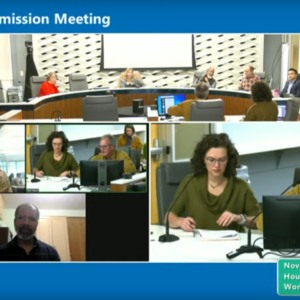
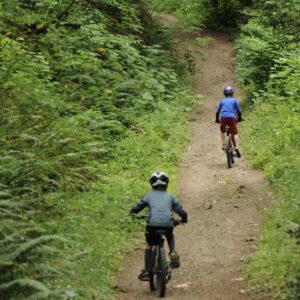
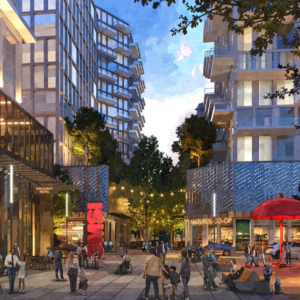
Thanks for reading.
BikePortland has served this community with independent community journalism since 2005. We rely on subscriptions from readers like you to survive. Your financial support is vital in keeping this valuable resource alive and well.
Please subscribe today to strengthen and expand our work.
Great report! Thanks.
I wasn’t there, and I don’t know his history – Did Terry Parker raise any valid concerns, or was he just knee-jerk anti-cyclist?
The vision expressed by George Crandall and Don Arambula is and has been long and widely held by all who have experienced cycle tracks firsthand and know the tremendously comfortable riding conditions they provide.
The Portland Bicycle Plan for 2030 purposefully introduces new facility types into consideration that far surpass standard bicycle lanes. The standard 5′ bicycle lane was previously the best on-street facility we had available to us. In this new bicycle plan we identify treatments for busy roadways as “separated in-roadway” to indicate that the treatment could range from bicycle lane to buffered bicycle lane to cycle track. We’ve also classified many more miles of commercial main streets as bikeways in recognition that all these roadways need to work well for cyclists because they present the types of destinations to which people want to go.
No, our difference is really only in terms of strategy. Is Portland now ready to wholesale remove on-street travel lanes and on-street parking necessary to create cycletracks in all our commercial districts? We don’t think so, though we are certainly prepared to advance such designs as we did this summer and will do with a cycle track on Cully Boulevard.
If more and more people were riding bicycles would we then be ready to? Quite likely. Whatever our approach we really must be oriented to creating conditions so that as many people use bicycles for transportation as soon as possible.
I think Crandall and Arambula now advocating for these treatments reflect how far the city has come. It wasn’t that long ago that they–as part of the Interstate MAX project team–were decrying the striping of bicycle lanes on Interstate Avenue because they would introduce curvilinear elements to a street that was otherwise straight. That they now, only five years, later strongly support cycle tracks reflects true progress in their thinking about urban design.
Jonathan:
I’ve been critical of your work lately so I thought it only fair to praise today’s article. This is what BikePortland does best and what you should focus your efforts on. Full interviews with some of the major players (Chris Smith, Roger Geller, the folks involved with the Trails proposals) would further inform (and perhaps inspire) folks here about the issues that could have a serious impact on their future.
pdb: Terry Parker posts on another local forum, and rails against bicycles in just about every post he makes (whether or not bicycles had anything to do with the post he was commenting on). He refuses to recognize the fact that most cyclists also have cars, and thus pay fuel taxes and registration fees that pay for local infrastructure, and he also ignores the fact that the federal taxes we pay also go towards road projects that don’t benefit cyclists in any way. He’s the ultimate crank.
Cyclist: good to know. Thanks for the info.
The Crandall Arambua critique of the plan is interesting, but misguided. To bring cycletrack / buffered bike lane facilities to Portland would be incredibly expensive and would be unlikely to entice the nearly 60% of “interested but concerned” potential riders that are intimidated by large streets with high auto traffic. Said differently, cycletracks should certainly be part of any bike master plan, but CA’s insistence that they be the focus denies the real funding issues for bike infrastructure and might not result in the transformative culture change that the City’s more rational, incremental focus on “bike boulevards” promises. So that’s the clear-headed argument. Having just done an hour-long web search on Crandall Arambula and their projects, I’m not convinced that they have the backing to be making such claims. They’re not really bike experts, and they have actually gotten very little built despite all of their “national experience….”
Terry Parker cracks me up every time. HILARIOUS, like milk through the nose hilarious.
There was a good line towards the bottom of the Oregonian Hard Drive linked at the beginning of this BP post “unruly town halls on health care reform”.
In reference to anti-bike voice mail rages left for him:
“Obviously, these issues are becoming increasingly about culture as much as transportation.”
No matter what sort of bike infrastructure you might support (on street-full VC, bike lanes, boulevards, cycle tracks, or off street MUP) a lot of the problem seems to be people that think that bicycles have no place in public. These people have isolated themselves in a world of manufactured information and rhetoric that they believe is factual.
It would be convenient to blame the Internet for this but people have always segregated themselves in to groups of like minded individuals: we’re guilty of it here(that’s why I like hearing from Vance even if I don’t agree with what he says).
But when these people call for the revocation of rights of a group of citizens based on personal prejudices it needs to be dealt with by education.
When these people promote harming or killing cyclists or pedestrians they need to be reminded that that behavior will not be tolerated
They can believe what ever they want but as soon as they are infringing on the rights of others it is a criminal act that harms everyone.
Hoover Pendleton #7: I thought the same thing about Crandall Arambua’s stance. We can’t let the perfect be the enemy of the good here, when you consider how much progress we’ve made as a city in the last 15 years, especially considering how little money we’ve put into bike infrastructure so far, you begin to realize that the small, incremental approach can bear significant fruit.
That’s not to say that I don’t want to see significant infrastructure improvements, I think the Sullivan’s Gulch and North Portland Greenway folks have exactly the right idea. The point is that if spending a relatively small sum on bike boulevards only gets us to a 15% mode share, that’s still more than double of what we had in 2008, and it’s a lot easier to argue for increased funding with a 15% modeshare than it is w/ a 7% modeshare.
Seeing that bike and ped facilities get less than one percent of the total PBOT budget, would you consider an initiative to incease funding on the local level? Not neccessarily a levee, but a policy direction that requires bike and ped projects getting double the amount they now get? This would not preclude going after federal dollars, would actually make it easier to find match money for grants. Even a 10% match can be a deal breaker for the City.
It may already be on the horizon. I don’t know. But it appears to me that finances are limiting decision and policy on the BMP. The will is there but the money aint. Since the City has other policy directives that mandate a change in the way we get there…Climate Change Policy, Transportation System Plan,and increasing bike and ped use is the cheapest,smartest, easiest way to get there, why not do it by improving funding and construction that meet those goals?
H-P (#7):
“They’re (C-A) not really bike experts, and they have actually gotten very little built despite all of their “national experience….”
yes, this all strikes me as slightly disingenuous, especially since they fought very hard against the bike lanes on Interstate Ave., as Mr. Geller points out. And, no, they weren’t suggesting a cycle track as an alternative at the time…
why not implement the crandall arambula vision of high quality cycle tracks in the hawthorne corridor between downtown and 39th, afterall isnt this the busiest route and the place where this investment makes the most sense? then just expand from this starter line
Ponch,
The Hawthorne Streetscape Plan of some years back was about exactly that, reducing the auto lanes from 4 to 2 with left turns, and adding bike lanes (the best thing at the time). Staff supported this plan, and said it wouldn’t divert that much auto traffic. It was defeated by the Advisory Committee for the project, on like a 4-3 vote. What we got was four Bike Oases, and some curb extensions. Businesses were worried about reduction of traffic, and some neighbors I guess, about diversion. Recently, adding a streetcar on Hawthorne was omitted from the Streetcar Plan because businesses opposed the reduction from 4 to 2 lanes this would require.(I think that the lane reduction would allow separated bike tracks so as to mitigate the rail issue, as currently planned for NE 9th (7th?) in the Lloyd District.)
There needs to be a political will to support a more progressive thinking for Hawthorne. I don’t know what it would take to get that.
On the “bike blvd vs cycletrack” issue, I feel that beefed-up bike blvds could easily outperform cycletracks in Portland.
Vancouver BC has the best Bike Boulevards anywhere. They are the backbone of the bike commute system. They have 2 key characteristics that Portland lacks
* Signalized intersections at all major cross streets (“Half Signals” of their own style — blinking green light on the arterial street, which turns to yellow and red when a bicyclist or pedestrian pushes the button)
* somewhat more frequent use of traffic diverters.
If Portland’s bike blvds diverted car traffic every 10 blocks and had “half signals” at all major cross streets (**timed** half signals, even, for 12 mph traffic) you could cruise across town on, say, Ankeny St. much faster than you could on a cycletrack on Burnside.
The problem with cycletracks on busy streets is the additional signal cycle time required to let right turn movements cross the cycletrack. (unknown, of course, since none exist yet) but I think you’d have a narrower, more congested, and slower ride on a Burnside cycletrack than an Ankeny Bike Blvd that was beefed up to B.C. standards.
Plus you’d be stuck in a narrow canyon of buildings with a bunch of cars.
I think the Bike Master Plan is headed in a very good direction, doing bike blvds first to further build ridership, then ramp up the cycletrack program.
Ted Buehler
I made two comments at this meeting:
1) The plan needs to incorporate improvements to route to Hayden Island/Vancouver WA, in particular provide a route that is *not* on a 45 – 55 mph truck route (the plan still shows “Plain Jane” bike lanes for Interstate north of Paul Bunyan and MLK from Columbia Blvd to Marine Dr).
2) Someone needs to take a little initiative and say “Portland needs to take X% of the Transportation $ each year and spend it on bike/ped projects.” I invited the Planning Commission to do this. The Oregon legislature did it in 1971, it’s high time Portland caught up.
Ted Buehler
I’ve got to agree w/ Geller and Pendleton – the incremental approach is the way to go (and Crandall Arambula just want to get some of the glory).